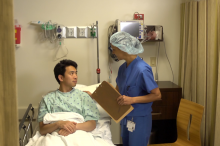
We all know that sun exposure has been linked to skin cancer. What most people don’t think of when applying skin protection or sunscreen is that the eyelids and eyes are also subject to this radiation exposure. Many skin tumors can develop along the eyelids, and the eye can be subject to growths that may require surgical removal.
The Orbital Surgery Center of Excellence in Los Angeles specializes in tumors, orbital infections, eye cancer and other issues that can affect the mid-face area. Our team of expert oculoplastic facial surgeons specializes in the most modern, minimally-invasive surgical techniques, including eyelid reconstruction and orbital surgery. If you are experiencing the symptoms of an orbital tumor or skin cancer of the eyelid, you can speak with our doctors at the Orbital Surgery Center of Excellence to learn more about your treatment options.
To schedule a consultation, feel free to contact us at (888) 559-4341.
Types of Eyelid Cancers
There are several skin cancers that affect the eyelids that have been linked to sun exposure. Some of the most common eyelid tumors are:
- Basal cell carcinoma is the most common malignant eyelid tumor. It initially appears as a firm nodule that ulcerates in the center and has tiny blood vessels within. Thankfully these tumors do not metastasize, but they are locally aggressive, destroying nearby normal tissue and requiring eyelid surgery for removal.
- Squamous cell carcinoma is a less common but much more aggressive skin cancer that can metastasize. This skin cancer is scaly in appearance and has also been linked to sunray exposure and radiation. They need to be surgically removed and may require radiation therapy.
- Malignant melanoma is the most serious skin cancer. Melanomas can appear as irregular moles, and it is important that they are removed fully so they don’t spread.
- Sebaceous cell carcinoma is a rare cancer that originates from the meibomian glands, which produce oils for the eyes.
Growths of the Orbit
Sun exposure has been linked to several growths on the orbit. These growths are benign but may obstruct your vision and require surgical removal. The following growths can be found on the orbit:
- Pinguecula is a benign growth from a raised thicken portion of the conjunctiva on the sclera or white part of the eye, close to the edge of the cornea.
- Pterygium is an elevated and wedged-shaped, benign growth of the scleral conjunctiva. Pterygiums can invade the cornea and can form scar tissue on the eye.
Prevention of Eyelid and Orbital Growths
Radiation from sun exposure in the form of UVA and UVB has been linked to skin cancers and orbital growths. The best prevention is the use of sunglasses and hats that cover the eyes. Unfortunately, there is no standard when it comes to eyewear protection but you should look into the level UV protection before buying them.
Treatment for Growths of the Orbit and Eyelid
The cancerous growths of the eyelids and benign orbital growths can be removed by our expert oculoplastic surgeons. Eyelid reconstruction is done via the Mohs procedure to ensure complete removal of the growths. During the Mohs procedure small sections are removed and examined under a microscope to ensure that all the cancerous growth has been removed, while maintaining as much normal tissue as possible.
Contact an Oculoplastic Surgeon in Los Angeles
If you are interested in learning more about eyelid reconstruction and orbital surgery options, contact the Orbital Surgery Center of Excellence. You can schedule an appointment with one of our doctors by calling (888) 559-4341 or by filling out our online contact form.
Next, check out our eye surgery before and after photos.














